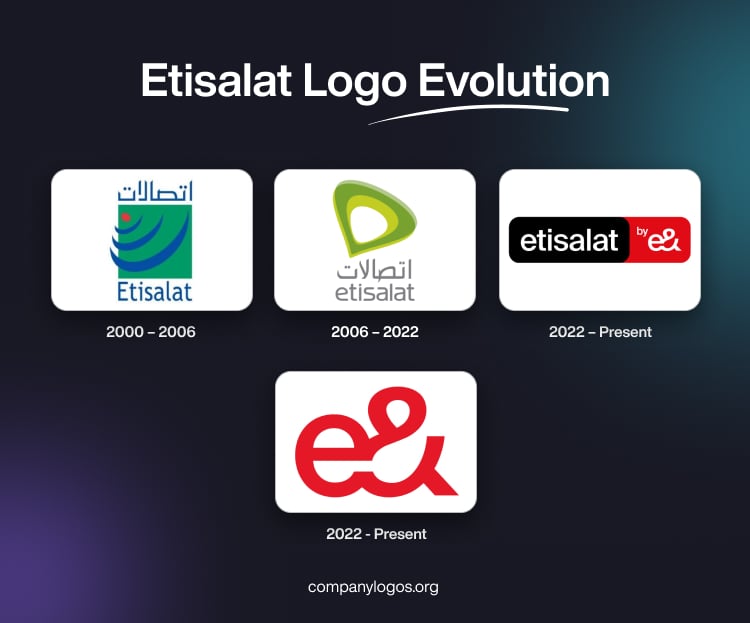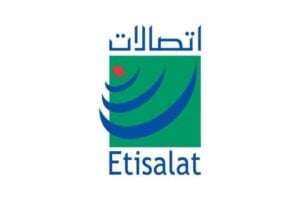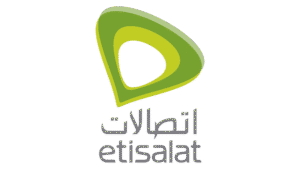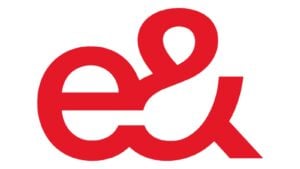
Etisalat, or Emirates Telecommunication Group Company, was founded in 1976 in Abu Dhabi. It has since grown from a national telecommunications provider into a global technology and investment conglomerate. The company operates in fifteen countries across the geographies of the Middle East, Asia, and Africa and offers a host of services.
The services include mobile telephony, fixed-line voice and data services, IPTV, and broadband connectivity. Its logo has evolved significantly over nearly five decades and reflects the company’s expanding ambitions and the shifting landscape of the telecom industry. The article explores the logo changes undertaken by Etisalat over the years, among other details.
The Genesis of the Etisalat Logo (2000 – 2006)
The original Etisalat logo was introduced in 2000, and it featured a red dot and three blue curves over a dark green square. The red dot represented the origin of a signal, while the blue curves symbolised the propagation of that signal. These were explicit visual metaphors for mobile communications. At the top of the green square was mentioned the brand name in Arabic, while the bottom of the square saw the brand name in English – all in blue.

(2006 – 2022)
The 2006 logo symbolised a slanted water drop turned upside down. It represented communication as a liquid flowing, similar to the other logos of telcos. The logo comprised the water drop emblem in various shades of green to represent the national colour of the UAE. The colour symbolises life, renewal, and growth. And below the emblem was written the name of the company in grey. The name was executed in both Arabic and English in two levels.

(2022 – Present)
On February 23, 2022, Etisalat Group announced a transformative rebrand. Consequently, it adopted the new group identity “e&” to reflect its evolution into a global technology and investment conglomerate. The UAE telecom business was rebranded as “etisalat by e&” to align the local brand with the parent company’s new vision while maintaining its established name in the UAE.
Two variants of the logo were created, where the first features a horizontal rectangle in black and red with rounded angles. On the left black part of the rectangle is written “Etisalat” in white lowercase and in a modest sans-serif typeface. The smaller red part of the rectangle on the right has the lowercase “by” and the merged elements of “e” and the ampersand sign – in white.
The lowercase “e” represents “electronic” and “ethernet”, while the ampersand “&” symbolises the expanding range of services. The modern, dynamic, and customer-centric design signals Etisalat’s focus on digital transformation and innovation.

(2022 – Present)
In another logo version unveiled in the same year (2022), the lowercase “e” and the ampersand (&) were displayed in a dark red colour against a white background. The merged elements were executed in thick clean lines with their ends showing straight cuts.

The Elements of the Etisalat Logo
Font
The Etisalat logo uses the ITC Benguiat Gothic Std Medium font for its English text. Designed by Edward Benguiat, this typeface is a modern sans-serif font that combines clarity with a distinctive, slightly geometric style. The font makes it suitable for a technology and telecommunications brand. The font conveys professionalism, modernity, and approachability.
The Arabic part of the logo was created by Tarek Atrissi Design. This Arabic typography harmonises with the Latin font and preserves the spirit of traditional Arabic script.
Colour
The current logo of Etisalat employs a colour palette comprising black, red, and white.
The History of Etisalat
Etisalat, originally known as Emirates Telecommunications Corporation, was established on August 1, 1976, in Abu Dhabi as a joint-stock company. The founding partners included International Aeradio Limited, a British company, and local Emirati partners. In its early years, Etisalat was tasked with developing and managing the UAE’s nascent telecommunications infrastructure. In a short time, it became the country’s first telecom service provider.
In 1983, the ownership structure shifted, wherein the UAE government acquired a 60% stake in Etisalat and the remaining 40% was traded publicly. This period marked the beginning of Etisalat’s dominance in the UAE telecom sector. The company expanded its network rapidly by increasing the exchange lines from 36,000 in 1976 to over 737,000 by 1998.
A significant milestone came in 1991 with the enactment of Federal Law No. 1, which granted Etisalat exclusive rights to provide wired and wireless telecom services within the UAE and internationally. The law also empowered Etisalat to regulate and control the telecom sector, thereby effectively establishing a government-sanctioned monopoly. This legal framework enabled Etisalat to drive the UAE’s telecom development and safeguard national interests. In 1994, Etisalat launched the Middle East’s first GSM service and kickstarted mobile communications in the region.
In 1995, Etisalat became the first provider of Internet services in the UAE, and by 2002, its subscriber base had reached 2 million. In 2004, Etisalat launched the first 3G network in the Middle East. In 2010, the company adopted fibre-optic networks and introduced 3DTV. In doing so, it joined a handful of global telecoms that offered such advanced services. During this era, Etisalat also expanded its international footprint. It established points of presence in major global cities and entered into hundreds of roaming agreements.
Etisalat also diversified its offerings to include media, consultancy, SIM card manufacturing, payment solutions, and more. Through these offerings, it served both individuals and enterprises. On February 24, 2022, the Etisalat Group underwent a major rebranding exercise. It adopted the new identity “e&” to reflect its evolution into a global technology and investment conglomerate. Consequently, the UAE telecom business retained the “Etisalat” name locally, now branded as “etisalat by e&”. At the same time, the group’s new identity signalled ambitions beyond traditional telecommunications and focused on digital transformation and global expansion.
Etisalat is ranked among the world’s largest telecom operators by subscribers and market capitalisation. It is a key contributor to the UAE’s economic development outside the oil sector and is recognised for its nationalisation programmes and technological leadership.
Interesting Facts About Etisalat
- Etisalat was founded in 1976 as a joint-stock company between a British firm, International Aeradio Limited, and local Emirati partners. This marked the start of telecommunications development in the UAE.
- Etisalat is the largest carrier of international voice traffic in the Middle East and Africa and ranks as the 12th largest voice carrier globally.
- The company operates an extensive network of 510 roaming agreements covering 186 countries. It enables seamless international connectivity for its customers.
- Etisalat was the first telecom operator in the Middle East and North Africa (MENA) region to commercially launch a 5G LTE network in May 2018.
- In 2024, Etisalat’s telecommunications division, under the new group identity “e&”, set a world record for the fastest speed on a live 5G network. It reached 30.5 Gbps and demonstrated its innovation in network capabilities.
- Etisalat is recognised as the strongest telecom brand in the Middle East and Africa and holds a AAA rating with a Brand Strength Index score of 89.2 out of 100. This places it among the top 20 strongest brands globally.
- During the COVID-19 pandemic, Etisalat played a critical role by providing free internet services, healthcare support, and digital solutions. It helped keep the UAE connected while boosting its infrastructure to support 5G networks.
- Etisalat is a major Internet hub in the Middle East, and it provides connectivity to other telecom operators and operating points of presence in global cities like New York, London, Amsterdam, Frankfurt, Paris, and Singapore.
- The company has been a significant contributor to the UAE’s economy outside the oil sector. It supports national development programmes and started nationalisation initiatives.
- Etisalat has diversified beyond traditional telecom services into areas such as cloud computing, media streaming, gaming, and FinTech. This reflects its transformation into a global technology conglomerate under the “e&” brand.
- The company has a popular service that allows users to check their mobile number by dialling *101#, which is a simple but useful feature for customers.
- Etisalat sponsors several international sports events. These include being an official sponsor of the Cyprus First Division football club Anorthosis Famagusta.
Finally
The various changes to the Etisalat logo show the transformation of the company from a national telecom provider to a global technology leader. Each rebranding phase has been carefully aligned with major strategic shifts—whether embracing mobile technology, expanding internationally, or leading digital transformation. Today, “etisalat by e&” stands as a symbol of both heritage and forward-thinking innovation. It is poised to connect and empower societies in a hyper-connected world.